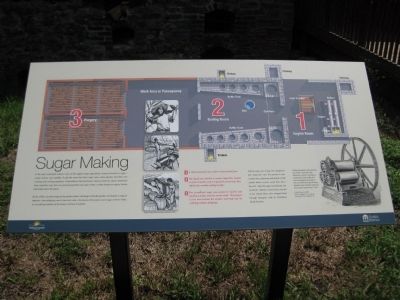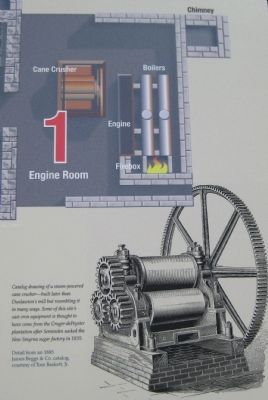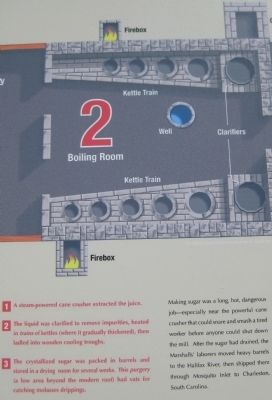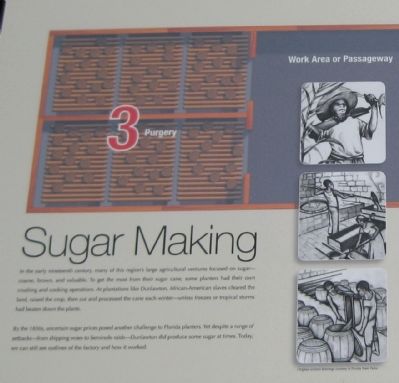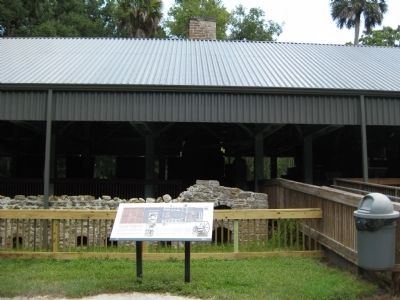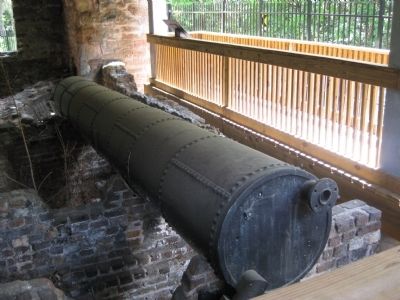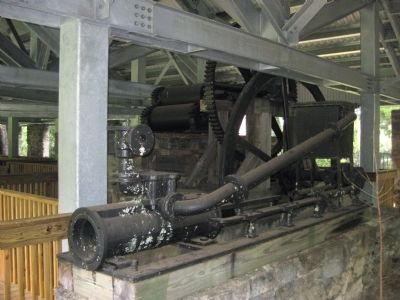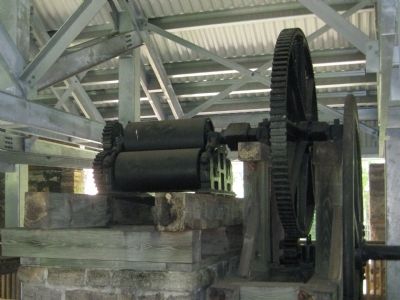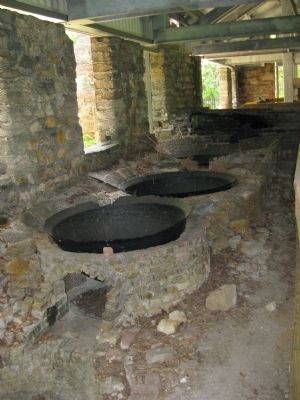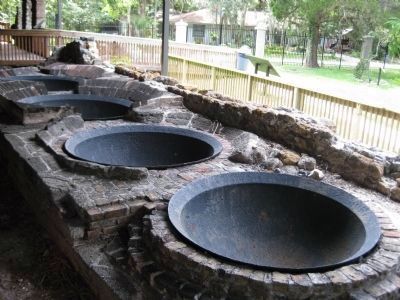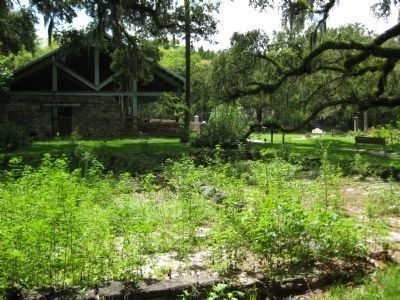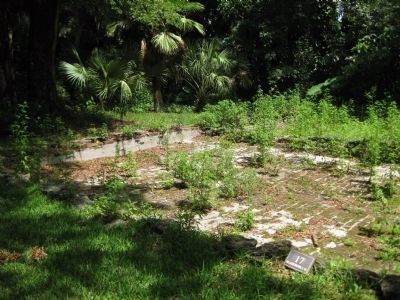Port Orange in Volusia County, Florida — The American South (South Atlantic)
Sugar Making
By the 1830s, uncertain sugar prices posed another challenge to Florida planters. Yet despite a range of setbacks - from shipping woes to Seminole raids - Dunlawton did produce some sugar at times. Today, we can still see outlines of the factory and how it worked:
1 - Engine Room: A steam-powered cane crusher extracted the juice.
2 - Boiling Room: The liquid was clarified to remove impurities, heated in trains of kettles (where it gradually thickened), then ladled into wooden cooling troughs.
3 - Purgery: The crystallized sugar was packed in barrels and stored in a drying room for several weeks. This purgery (a low area beyond the modern roof) had vats for catching molasses drippings.
Making sugar was a long, hot, dangerous job - especially near the powerful cane crusher that could snare and smash a tired worker before anyone could shut down the mill. After the sugar had drained, the Marshall's laborers moved heavy barrels to the Halifax River, then shipped them through Mosquito Inlet to Charleston, South Carolina.
[ Image ]
Catalog drawing of a steam-powered cane crusher - built later than Dunlawton's mill but resembling it in many ways. Some of this site's cast-iron equipment is thought to have come from the Cruger-dePeyster plantation after Seminoles sacked the New Smyrna sugar factory in 1835.
Detail from an 1885 James Beggs & Co. catalog, courtesy of Tom Baskett, Jr.
[ Illustrations ]
Original workers drawings courtesy of Florida State Parks.
Erected by Volusia County and the State of Florida, Department of State, Division of Historical Resources, assisted by the Florida Historical Commission.
Topics. This historical marker is listed in these topic lists: African Americans • Agriculture • Industry & Commerce. A significant historical year for this entry is 1835.
Location. 29° 8.473′ N, 81° 0.35′ W. Marker is in Port Orange, Florida, in Volusia County. Marker is on Old Sugar Mill Road east of Herbert Street, on the left when traveling east. The marker is on the grounds of the Dunlawton Sugar Mill Botanical Gardens. Touch for map. Marker is at or near this postal address: 950 Old Sugar Mill Road, Port Orange FL 32129, United States of America. Touch for directions.
Other nearby markers. At least 8 other markers are within walking distance of this marker. Dunlawton's Building Blocks (here, next to this marker); The Dunlawton Sugar Factory (here, next to this marker); The Most Dangerous Chieftain (a few steps from this marker); From the Boardwalk (a few steps from this marker); Telling Dunlawton's Stories (a few steps from this marker); Spanish Mills and Bongoland (a few steps from this marker); Living on the Edge (a few steps from this marker); Working (a few steps from this marker). Touch for a list and map of all markers in Port Orange.
More about this marker. The marker features a large map of the layout of the mill structure, showing how each area was used.
The marker features the logos of Volusia County and the Florida Heritage program.
Regarding Sugar Making. The site was listed with the National Register of Historic Places in 1973 under the name Dunlawton Plantation--Sugar Mill Ruins (# 73000606).
Related markers. Click here for a list of markers that are related to this marker. To better understand the story of the Dunlawton Plantation and Sugar Mill Ruins, study each marker in the order shown.
Credits. This page was last revised on June 16, 2016. It was originally submitted on August 26, 2011, by Glenn Sheffield of Tampa, Florida. This page has been viewed 677 times since then and 16 times this year. Photos: 1. submitted on August 26, 2011, by Glenn Sheffield of Tampa, Florida. 2, 3, 4, 5, 6, 7, 8, 9, 10, 11, 12. submitted on August 27, 2011, by Glenn Sheffield of Tampa, Florida. • Bill Pfingsten was the editor who published this page.
